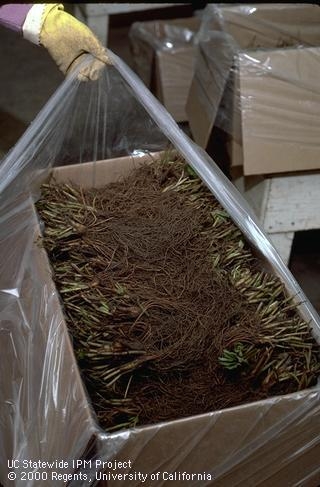Review of Chill for the UC Day Neutral Strawberry Varieties Albion, San Andreas and Monterey
I had a conversation quite recently with Doug Shaw, UC plant breeder, concerning the concept of chill in the day neutral varieties and the desire of some Central Coast growers to reduce the recommended amounts significantly, even all the way down to zero days of chill:
In the way of review, please recall that chill requirement in strawberry in California is made up of two essential parts. One part is what the plant accumulates in the field before being harvested, and the other is accumulation of chill after harvest and the plant is in storage. There is a big difference between the two and one does not supplant the other. In-field chill takes place when the plant is still in the soil, out in the open and still has all its leaves. Supplemental chill takes place after harvest of the plant and occurs in a constant near freezing temperature, in the dark and the plant has none to very few leaves left (Figure 1 below).
Accumulation of chill, especially supplemental chill, in the strawberry transplant makes it stronger and better able to survive the stress of plant harvest, transplant and the growing season beyond.
As some of the chill sensitivity has been bred out of the modern UC day neutral varieties such as Albion, Monterey and especially San Andreas, it is indeed possible to grow these varieties with less than the recommended amounts (10-18 days) of supplemental chill. However, those who choose to reduce chill below these amounts should recognize the amount of risk they are taking and that this is not an exercise for those still using training wheels. Should growing conditions take a turn for the worse, these underchilled plants do not have the vigor to help them pull through and will suffer more than those adequately chilled. Moreover, while UC day neutral strawberry plants chilled significantly less than the recommended 10-18 days can produce fruit earlier than others (probably owing to the earlier planting date), these plants quite likely will not perform optimally in terms of overall yield and quality along with showing a tendency to produce smaller fruit later on in the season.
The only case where one would want to go short on supplemental chilling time would be if the plant harvest was so late that a minimum chill time of 10 days would result in a planting date so late that it would compromise plant growth and establishment.
Other than that, it is still recommended to give the UC day neutral varieties 10-18 days of supplemental chill.

Trimmed transplants being packaged in box with polyethylene lining, ready for placement into the cooler for supplemental chilling.


Posted by John Sandison on January 13, 2016 at 3:46 AM